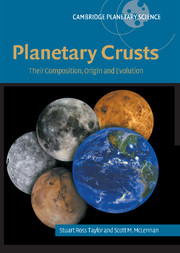Book contents
- Frontmatter
- Contents
- Preface
- Acknowledgments
- List of abbreviations
- Prologue
- 1 The planets: their formation and differentiation
- 2 A primary crust: the highland crust of the Moon
- 3 A secondary crust: the lunar maria
- 4 Mercury
- 5 Mars: early differentiation and planetary composition
- 6 Mars: crustal composition and evolution
- 7 Venus: a twin planet to Earth?
- 8 The oceanic crust of the Earth
- 9 The Hadean crust of the Earth
- 10 The Archean crust of the Earth
- 11 The Post-Archean continental crust
- 12 Composition and evolution of the continental crust
- 13 Crusts on minor bodies
- 14 Reflections: the elusive patterns of planetary crusts
- Indexes
- References
14 - Reflections: the elusive patterns of planetary crusts
Published online by Cambridge University Press: 22 October 2009
- Frontmatter
- Contents
- Preface
- Acknowledgments
- List of abbreviations
- Prologue
- 1 The planets: their formation and differentiation
- 2 A primary crust: the highland crust of the Moon
- 3 A secondary crust: the lunar maria
- 4 Mercury
- 5 Mars: early differentiation and planetary composition
- 6 Mars: crustal composition and evolution
- 7 Venus: a twin planet to Earth?
- 8 The oceanic crust of the Earth
- 9 The Hadean crust of the Earth
- 10 The Archean crust of the Earth
- 11 The Post-Archean continental crust
- 12 Composition and evolution of the continental crust
- 13 Crusts on minor bodies
- 14 Reflections: the elusive patterns of planetary crusts
- Indexes
- References
Summary
It is difficult to make predictions, especially about the future
(folklore)Too many variables
On commencing this study, we were hopeful of reaching some general conclusions about the origin and evolution of crusts, at least on the terrestrial planets. However a survey of the previous chapters reveals little that might assist one in predicting any of the details of crustal development. Crusts of many types are present but they are characterized by differences rather than similarities; there are more variables than there are planets. As with most aspects of planetology, reaching general conclusions or deriving some widely applicable principles remains elusive. Rather than the terrestrial planetary crusts representing points on a continuum of evolutionary style, crustal evolution is governed largely by stochastic processes that also influenced the origin and evolution of the planets themselves. So there are too many variables and too few outcomes to allow for any kind of statistical treatment, just as the accretion of the terrestrial planets, as we have seen in Chapter 1, is essentially a stochastic process, with outcomes impossible to predict.
Although it is possible to classify crusts on the terrestrial planets into “primary”, “secondary” and “tertiary” (Section 1.5), this does not imply any logical or inevitable sequence of development. Thus both the primary anorthositic crust of the Moon and the tertiary continental crust of the Earth are unique (Fig. 14.1). So like many classifications, distinguishing the different types of crusts provides convenient pigeonholes but has little predictive power.
Information
- Type
- Chapter
- Information
- Planetary CrustsTheir Composition, Origin and Evolution, pp. 352 - 363Publisher: Cambridge University PressPrint publication year: 2008
